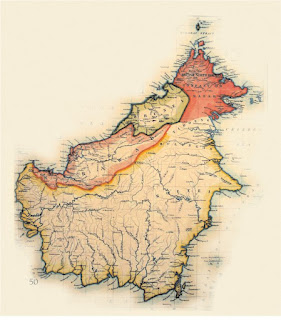Dear Koyoh and Gurongit, it pays to know your history so you
don’t burst a vein every time some folks say Sabah
belongs to them. Many people repeat stuff they’ve heard, about
something they know nothing about. With that in mind, I suggest you check the
facts and don’t take everything I’m saying here as the truth although I’ll tell
you as closely as possible what I’ve learnt about Sabah
of the 1800s.
This was a period, long past long ago, when pirates prowled
along the coasts and headhunters roamed the countryside. It was long before the
word ‘Sabah ’ magically evoked images of black
gold and dollar signs, and ages before the natives discarded their loin-cloths
for made-in-Thailand underwear.
 |
| An old map of Brunei |
Sabah (North Borneo) was still under Brunei Brunei used to be a huge part of Borneo ? The Brunei Sultanate stretched all the way from
present day Sarawak to the tip of Borneo . Apparently,
from the very beginning we, the natives, have been the source of income for
various sultans and pengirans of Brunei
Then the white men came…
The Americans were never really interested in Sabah . However, they did offer protection to Brunei Brunei Borneo in the early 1800s.This was
mainly for commercial interests, not colonial expansion.
1845: The USA
offered Brunei Brunei
1850: The USA
obtained commercial privileges and right to establish a consulate in Brunei
1865: The USA
established a consulate in Brunei
Moses was more interested in making money for himself. He
saw that the Sultan hoped to use US
presence in Brunei as a counter-weight
against Sarawak expansion. (The Sultan had
given Sarawak to James Brooke in 1846 for the latter’s role in curbing piracy…
and now James Brooke wanted Sabah too!)
 |
| Borneo (Google Image) |
With the dwindling empire/sultanate, the Sultan and his
pengirans were getting less rich due to
loss of income because there were fewer subjects from whom to collect poll-taxes.
Moses shrewdly persuaded the Sultan to lease him large concessions in Sabah for yearly rents.
Sultan Abdul Mumin leased the land from the Sulaman River
to the Paitan River Sandakan
(Note: Brunei
Moses was now ‘lord and master’ of huge tracts of land in Sabah leased from the Sultan. Was he going to develop the
land? No. This was before the rubber era of the next century. Was he going to
collect taxes on the inhabitants of his concessions? No! Moses quickly left for HK and was able to
sell his concessions to two Americans—Joseph William Torrey and Thomas Bradley
Harris, and a Chinese named Wo Hang.
 |
| Harris and Torrey (Google Image) |
Torrey formed the America Trading Company of Borneo (ATC) to
develop the land he had acquired.
Sultan Abdul Mumin signed a document on 24 November 1865
appointing Torrey as Rajah of Ambong and Maroodoo with the powers of life and
death over the inhabitants; the right of making laws, coining money, creating
an army—together with the powers and rights usually exercised by and belonging
to sovereign rulers. So, Torrey was made a white rajah just like James Brooke
in Sarawak !
With 12 Americans and 60 Chinese, the ATC opened a
settlement in Kimanis. The new settlement was given a pretty name: Ellena. The
plan was to develop commercial agriculture planting sugar cane, tobacco and
rice. Unfortunately, the company had to be abandoned at the end of 1866 due to
a number of reasons. Thomas Harris died after suffering a high fever. There was
shortage of capital; there was sickness among the settlers and there was labour unrest.
 |
| Thomas B. Harris's tombstone at Kimanis |
Torrey returned to HK to look for someone who'd be interested to buy
his property. Among those who expressed interest in this far-flung wilderness
was Italy Sabah was perfect for a penal
outpost where convicts could be sent to exile! Didn’t happen, by the way. (Can
you imagine Romeos and Juliets labouring in the paddy fields and living in
little water villages?)
1875: Finally, after almost ten years of looking for a
buyer, an Austrian named Gustavus Baron Von Overbeck, offered Torrey $15,000
for the concessions if the Sultan of Brunei would renew the leases. The Sultan
refused! So, Overbeck, having been turned down by Vienna ,
turned to Dent Brothers (London
 |
| Alfred Dent (Google Image) |
1877: Alfred Dent saw great potential in the Sabah venture
so in March 1877 they formed the Overbeck-Dent Association (ODA) to obtain the Sabah leases with the intention of selling them for a
profit.
Dec 29, 1877: Sultan of Brunei leased his Sabah estates to
Overbeck and Dent for an annual payment of $16,000—except for some
tulin/private lands from Kimanis Bay in the west to the Kinabatangan River Sandakan
 |
| Photo credit: J. Kessey |
A few weeks after the Sultan of Brunei had leased his lands
to ODA, the Sultan of Sulu also sold his share of NB to Overbeck.
1883: Pangalat, Putatan, Kawang and Mantanani
Islands were leased by Brunei
1884: The Sultan of Brunei signed over the Padas and Klias Rivers
Jan 22, 1878: The Sultan of Sulu on the island of Maibu (
having been ousted from Jolo by the Spanish) relinquished his claim on all his
territories in return for $5000 [five thousand dollars] a year, the same land
the British was already paying $12,000 per year to Brunei.
1898: By 1898 the British NBCC owned the rights to every
square centimeter of land in Sabah .
Now, Koyoh and Gurongit, which part of Sabah
did some clown claim belong to them?
Love,
Aunty Tina
(p.s. Homework! Find out when the leases were transferred from ODA to
the NBCC.)
Reference: British North Borneo Herald

No comments:
Post a Comment